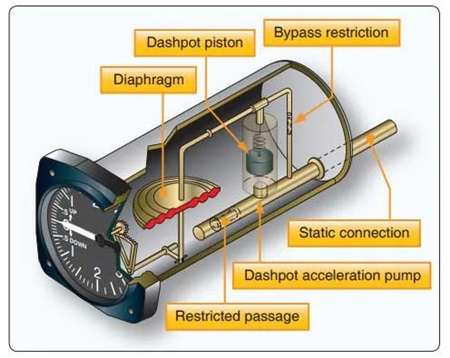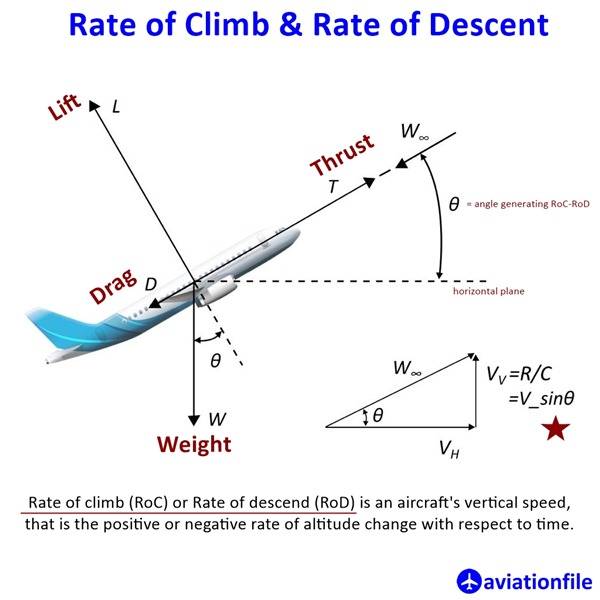Vertical Speed Indicator: An In-Depth Analysis of Its Functionality and Importance in Aviation
The Vertical Speed Indicator (VSI), also known as the Variometer, is a fundamental instrument in aviation, providing critical data on an aircraft’s rate of climb or descent. For pilots, understanding and effectively using the VSI is essential for maintaining safe altitude management and ensuring smooth flight operations. This article delves into the mechanics, types, operational principles, and limitations of the VSI.
1. What is a Vertical Speed Indicator (VSI)?
The Vertical Speed Indicator (VSI) is a vital component of an aircraft’s instrument panel, displaying the rate at which an aircraft is climbing or descending, measured in feet per minute (fpm) or meters per second (m/s). This information allows pilots to monitor vertical flight patterns and make critical adjustments to maintain desired altitude levels, particularly during takeoff, landing, and turbulent conditions.

image source
2. How Does the Vertical Speed Indicator Work?
The Principle of Pressure Differential
The VSI functions on the basis of differential pressure, a principle rooted in the mechanics of fluid dynamics. The instrument measures the rate of change in static pressure outside the aircraft, translating it into a rate of ascent or descent. As the aircraft climbs, static pressure decreases, while descending causes an increase in static pressure. The VSI captures these pressure changes to display real-time vertical speed.
Mechanics of the Diaphragm and Case
The VSI comprises a sealed case connected to the aircraft’s static port, allowing ambient air pressure to enter. Inside the case, a diaphragm directly connected to the instrument pointer expands and contracts as pressure changes. A calibrated leak (orifice) allows air to flow slowly into or out of the case, creating a lag between the diaphragm’s pressure and that of the static port. This lag represents the rate at which pressure changes occur, which is shown on the VSI’s dial as a rate of climb or descent.

3. Types of Vertical Speed Indicators
Analog vs. Digital
Analog VSIs are traditional instruments featuring a needle that moves along a circular dial, displaying the rate of climb or descent in increments (often 500 or 1000 fpm). These indicators provide real-time feedback but are subject to the limitations of mechanical precision and lag.
Digital VSIs, part of modern glass cockpit configurations, offer more accurate readings with minimal lag and can display exact numerical values. They integrate with other navigational systems, enhancing situational awareness by reducing the margin of error associated with analog instruments.
Inertial Reference Systems (IRS) Integration
In advanced aviation technology, the VSI is often integrated with the Inertial Reference System (IRS) in larger commercial or military aircraft. This integration reduces response time and improves accuracy by combining data from accelerometers and gyroscopes, independent of external pressure inputs. Consequently, IRS-equipped VSIs provide immediate, accurate vertical speed data, vital for high-stakes scenarios in complex airspaces.
4. Reading and Interpreting VSI Information
Proper interpretation of VSI data is critical to managing an aircraft’s altitude profile. The VSI dial features a zero mark at its center, with positive values indicating a climb and negative values a descent. Pilots use the VSI to set an optimal rate of ascent or descent, based on the aircraft’s operational capabilities and current atmospheric conditions. By cross-referencing VSI data with other instruments such as the altimeter and attitude indicator, pilots achieve a comprehensive understanding of the aircraft’s spatial orientation.
5. The Importance of the VSI in Flight Safety and Efficiency
The VSI is crucial for safe altitude management, particularly during transitional phases of flight, such as takeoff and landing, where altitude changes are rapid. The VSI provides:
- Vertical Speed Monitoring: Helping maintain a steady climb or descent rate to avoid altitude deviations.
- Altitude Stabilization: Essential for maintaining a stable flight path, especially during approach and landing, where excessive descent rates can compromise passenger comfort and structural integrity.
- Collision Avoidance: Integrated with other cockpit instruments, VSI aids in maneuvering away from potential mid-air conflicts, contributing to overall flight safety.
During instrument flight rules (IFR) operations, the VSI becomes even more indispensable. The limited visibility inherent to IFR conditions heightens the pilot’s reliance on instrument readings to gauge altitude changes. The VSI’s data assists pilots in adjusting their vertical speed to ensure safe separation from other aircraft and terrain.
6. Common Errors and Limitations of the VSI
While the VSI is highly reliable, certain limitations and errors can arise, including:
- Lag in Response: Due to the nature of the pressure differential mechanism, the VSI displays a slight delay. This lag can result in misinterpretation, especially during rapid altitude changes.
- Icing and Blockage: Static ports can become blocked by ice or debris, leading to inaccurate readings.
- Inherent Sensitivity to Turbulence: The VSI can register false climbs or descents during turbulent conditions, as it is sensitive to abrupt changes in pressure caused by air disturbances.
To counter these limitations, pilots are trained to interpret VSI data in context with other instruments, ensuring safe and accurate altitude adjustments.
7. Technological Advancements and Future Trends
Integration with Flight Management Systems (FMS)
The integration of VSI with Flight Management Systems (FMS) allows for more refined autopilot functions, including automatic vertical speed adjustments. By cross-referencing VSI data with the altimeter, GPS, and weather radar inputs, the FMS enables predictive descent profiles and smoother altitude transitions, conserving fuel and enhancing passenger comfort.
Artificial Intelligence and Predictive Maintenance
The role of AI in VSI technology extends to predictive maintenance, where machine learning algorithms analyze VSI performance to forecast potential malfunctions. This preemptive approach not only enhances safety but also reduces costs by preventing unexpected instrument failures.
Glass Cockpit and HUD Integration
Modern glass cockpit configurations often feature VSI data within a heads-up display (HUD), streamlining access to vertical speed information for easier reference during critical phases of flight. The HUD’s overlay of VSI data enhances situational awareness, allowing pilots to respond more intuitively to vertical speed changes without diverting their gaze from the flight path.
8. Conclusion
The Vertical Speed Indicator remains a cornerstone of aviation instrumentation, providing essential data that contributes to altitude management, flight safety, and operational efficiency. From traditional analog designs to advanced digital systems integrated with IRS and FMS technologies, the VSI has evolved to meet the demands of modern aviation. As technology continues to advance, we can expect further improvements in VSI accuracy, integration, and reliability, solidifying its role in the ever-evolving landscape of aviation safety and performance.
This comprehensive understanding of the VSI’s functionality, importance, and future potential reflects its undeniable significance in ensuring safe and efficient air travel. As aviation technology progresses, continued innovations in VSI technology will play a pivotal role in enhancing the precision and reliability of aircraft altitude management.
References and Further Reading
- https://www.mcico.com/resource-center/articles/instantaneous-vertical-speed-indicators-combat-lag-time
- https://ntrs.nasa.gov/citations/19800015804


